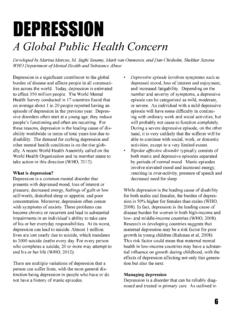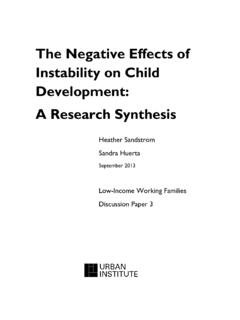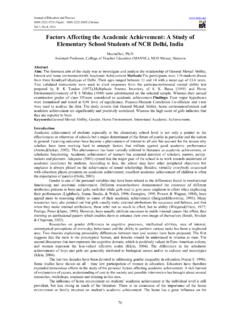Transcription of THE GLOBAL STRATEGY FOR WOMEN’S, CHILDREN’S AND ...
1 THE GLOBAL . STRATEGY . FOR WOMEN'S, children 'S AND. ADOLESCENTS'. HEALTH. (2016-2030). Every Woman Every Child 2015. THE GLOBAL STRATEGY FOR. WOMEN'S, children 'S AND. ADOLESCENTS' HEALTH. (2016-2030). TABLE OF CONTENTS. FOREWORD. from the UN Secretary-General 4. AT A GLANCE: The GLOBAL STRATEGY for Women's, children 's and Adolescents' Health (2016-2030) 6. 8. Why we need an updated GLOBAL STRATEGY 10. What's new in the GLOBAL STRATEGY ? 11. Building on the 2010 GLOBAL STRATEGY 13. 14. 4. 22. Spotlight on health challenges 24. The health equity gap within and between countries 30. 2. 34. Vision 36. Guiding principles 36. Objectives: Survive, Thrive, Transform 39. Targets 39. 46. 1. Country leadership 48. 2. Financing for health 50. 3. Health system resilience 54. 4. Individual potential 58. 5. Community engagement 60. 6. Multisector action 62. 7. Humanitarian and fragile settings 64.
2 8. Research and innovation 66. 9. Accountability for results, resources and rights 70. 74. Operational Framework 76. Every Woman Every Child architecture 76. Committing to action 80. The way forward 83. ANNEXES 84. REFERENCES 101. FOREWORD FROM THE. UN SECRETARY-GENERAL. UN Photo/Mark Garten 4. I launched the GLOBAL STRATEGY for Women's and children 's Health in September 2010 because I believed the GLOBAL community could and should do more to save the lives and improve the well-being of women and children . I have been greatly encouraged by the response, including the powerful multi-stakeholder Every Woman Every Child movement. A surge of new commitments and advocacy has helped to signi cantly advance the health-related Millennium Development Goals. With the publication of this updated GLOBAL STRATEGY for Women's, children 's and Adolescents' Health, and with agreement by Member States on an ambitious 2030.
3 Agenda for Sustainable Development, it is time to build on the momentum achieved over the past ve years. To ensure health and well-being for every woman, child and adolescent , we must build on what has worked in the past and use what we have learned to overcome existing and emerging challenges. Ful lling the GLOBAL STRATEGY and achieving the Sustainable Development Goals (SDGs) will require new evidence-based approaches backed by innovative and sustainable nancing mechanisms, such as the GLOBAL Financing Facility in support of Every Woman Every Child. The updated GLOBAL STRATEGY includes adolescents because they are central to everything we want to achieve, and to the overall success of the 2030 Agenda. By helping adolescents to realize their rights to health, well-being, education and full and equal participation in society, we are equipping them to attain their full potential as adults.
4 The three overarching objectives of the updated GLOBAL STRATEGY are Survive, Thrive and Transform. With its full implementation supporting country priorities and plans and building the momentum of Every Woman Every Child no woman, child or adolescent should face a greater risk of preventable death because of where they live or who they are. But ending preventable death is just the beginning. By helping to create an enabling environment for health, the GLOBAL STRATEGY aims to transform societies so that women, children and adolescents everywhere can realize their rights to the highest attainable standards of health and well-being. This, in turn, will deliver enormous social, demographic and economic bene ts. It is a grand vision. But it is achievable. By implementing the GLOBAL STRATEGY we can deliver a historic transformation that will improve the lives of generations to come.
5 To that end, I will continue to mobilize ambitious action from GLOBAL leaders and promote the engagement of all sectors of society. Together, we can end the preventable deaths of women, children and adolescents everywhere and create a world in which, for the rst time in history, all can thrive and reach their full potential. Ban Ki-moon 5. 1. 8. INTRODUCTION. 9. WHY WE NEED. AN UPDATED. GLOBAL STRATEGY . Today we have both the knowledge and the opportunity to end preventable deaths among all women, children and adolescents, to greatly improve their health and well-being and to bring about the transformative change needed to shape a more prosperous and sustainable future. That is the ambition of this GLOBAL STRATEGY for Women's, children 's and Adolescents' Health. The previous GLOBAL STRATEGY achieved great things between 2010 and It galvanized political leadership, attracted billions of dollars in new nancial commitments and created Every Woman Every Child, a powerful multi-stakeholder movement for health (see Annex 1).
6 2 The United Nations Commission on Information and Accountability for Women's and children 's Health3 resulted in a landmark Accountability Framework and an independent Expert Review Group (iERG)4, and the United Nations Commission on Life-Saving Commodities for Women's and children 's Health strengthened the availability and supply of essential Several GLOBAL action plans and reports were launched to address and bring attention to neglected areas with support for country implementation (see Annex 1). Millions of lives were saved and progress towards the health Millennium Development Goals (MDGs) was Strides were made in areas such as increasing access to contraception and essential interventions, reducing maternal and child mortality and malnutrition and combating HIV/AIDS, malaria and ,6,7. However, far too many women, children and adolescents worldwide still have little or no access to essential, good-quality health services and education, clean air and water, adequate sanitation and good nutrition.
7 They face violence and discrimination, are unable to participate fully in society, and encounter other barriers to realizing their human ,6,7 As a result, as the MDG era draws to a close, the annual death toll remains unacceptably high: 289,000 maternal deaths, million stillbirths, million deaths in children under the age of ve . including million newborn deaths and million adolescent Most of these deaths could have been prevented. Many more people suffer illness and disability and fail to reach their full potential, resulting in enormous loss and costs for countries both today and for future generations. That is why this updated GLOBAL STRATEGY is essential. We urgently need it in order to complete the un nished work of the MDGs, to address inequities within and 10. between countries and to help countries begin implementing the 2030 Agenda for Sustainable Development without delay.
8 This updated GLOBAL STRATEGY , spanning the 15 years of the SDGs,11 provides guidance to accelerate momentum for women's, children 's and adolescents'. health. It should achieve nothing less than a transformation in health and sustainable development by 2030 for all women, children and adolescents, everywhere. WHAT'S. NEW IN THE. GLOBAL STRATEGY ? This GLOBAL STRATEGY is much broader, more ambitious and more focused on equity than its predecessor. It is universal and applies to all people (including the marginalized and hard-to-reach), in all places (including crisis situations). and to transnational issues. It focuses on safeguarding women, children and adolescents in humanitarian and fragile settings and upholding their human rights to the highest attainable standard of health, even in the most difficult circumstances. For the first time, adolescents join women and children at the heart of the GLOBAL STRATEGY .
9 This acknowledges not only the unique health challenges facing young people, but also their pivotal role alongside women and children as key drivers of change in the post-2015 era. By investing in the right policies and programmes for adolescents to realize their potential and their human rights to health, education and full participation in society, we can unleash the vast human potential of this SDG Generation to transform our world. This GLOBAL STRATEGY takes a life-course approach that aims for the highest attainable standards of health and well-being physical, mental and social . at every age. A person's health at each stage of life affects health at other stages and also has cumulative effects for the next generation. Moreover, the GLOBAL STRATEGY adopts an integrated and multisector approach, recognizing that health-enhancing factors including nutrition, education, water, clean air, sanitation, hygiene and infrastructure are essential to achieving the SDGs.
10 11. UNICEF/BANA2006-01297/Siddique The survival, health and well-being of women, children and adolescents are essential to ending extreme poverty, promoting development and resilience, and achieving the SDGs. 12. HOW WAS. THIS UPDATED. GLOBAL STRATEGY . CREATED? The updated GLOBAL STRATEGY builds on all the essential elements of its predecessor, including: Support for country-led health plans Integrated delivery of health services and life-saving interventions and commodities Stronger health systems Suf cient numbers of skilled and well-equipped health workers Good-quality services Innovative approaches Improved monitoring, evaluation and accountability More than 7,000 individuals and organizations informed the drafting process through a GLOBAL consultation supported by Every Woman Every Child. The World Health Assembly 2015 and consultative regional meetings hosted by the Governments of India, South Africa and the United Arab Emirates were important occasions for consultation.
















